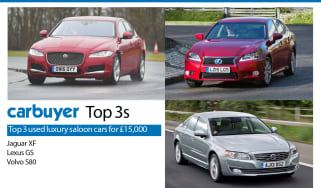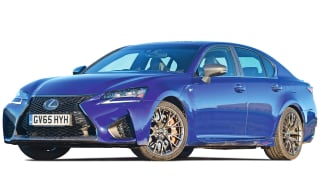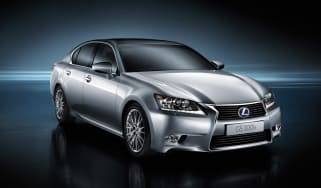Lexus GS saloon (2012-2018)
"The Lexus GS is a competent car, but it's up against very strong rivals from Mercedes, Audi and BMW"
Pros
- Relaxing to drive, but also very fast
- Much more spacious than before
- Well equipped and economical
Cons
- Not as much fun as a BMW 5 Series
- CVT gearbox makes engine noisy
- No diesel and flagship is pricey
The Lexus GS is part of a ‘fresh start’ for Toyota's upmarket brand. Not content with its reputation for building luxurious, reliable and well equipped cars, Lexus now wants to inject a bit of excitement into its products, promising that all models will look more stylish and be more fun to drive than before.
A rival to the BMW 5 Series, the GS features a totally redesigned body with a sharp-looking front end boasting LED headlights and a neat grille. The F Sport model takes things further, with a different design of front grille, a revised front bumper on the outside and aluminium trim flashes in the cabin. Under the skin, the completely new chassis features adaptive suspension and (on F Sport models) lots of gadgets to improve the handling.
On the engine front, there are two hybrids available in the GS; the GS 300h and the GS 450h, including a high-end Sport model.
At the top of the range there’s also the high-performance GS F, an alternative to the BMW M5.
MPG, running costs & CO2
The Lexus GS requires servicing every 10,000 miles and while Lexus offers a fixed-price three-year servicing deal, making budgeting easy, it’s likely to be more expensive to maintain than rivals like the Audi A6. Residual values aren’t great, with the Lexus unlikely to match those of high-performance BMW and Mercedes diesel models.
More reviews
In-depth reviews
Another negative is that while Lexus claims the GS 450h will return 46.3mpg, it can be hard to match that figure in everyday driving; hybrids have a reputation for falling well short of their headline economy figures and the GS is no different. All hybrid models cost £130 per year to tax, but if your GS has a list price of more than £40,000 it'll qualify for the yearly £310 surcharge, which will bring your total bill to £440 per year for five years.
The GS 450h emits 141g/km for a £145 road tax charge, while the Sport version has larger 19in wheels, which cause a small increase to CO2 emissions. They climb to 145g/km, which is enough to raise the BIK from 25 to 26%.
Fuel economy is much more impressive in the cheaper GS 300h, returning a claimed 64.2mpg, while the GS 450h should return up to 46.3mpg, although in truth we struggled to get more than 40mpg, let alone match the official figure of the GS 450h F Sport.
Engines, drive & performance
The old Lexus GS was a very relaxing car in which to travel long distances, but it wasn't much fun to drive. Improved suspension promises to make this version feel sportier, while remaining stable at a high-speed cruise. The electric power steering system has more weight, while the adaptive dampers soak up bumps well. You can choose from Eco, Normal, Sport and Sport+ driving modes, which alter the response of the engine, steering and suspension, but regardless of the mode you select, the GS is still not as good to drive as a BMW 5 Series.
The Lexus GS F Sport has a glorious 5.0-litre V8 engine and is a seriously quick car. It’s fitted with advanced technology, including four-wheel steering and a variable-ratio steering rack, as well as a bodykit and 19-inch wheels. But while it's more agile than the standard GS and a very impressive car overall, it costs a whopping £69,995 – almost as much as the superior BMW M5.
The GS 450h mixes a 3.5-litre V6 petrol engine with an electric motor for a hefty combined output of 341bhp - enough for a 0-62mph time of under six seconds and top speed of 155mph. This power is transmitted to the rear wheels via Lexus’s Shiftmatic - which is, in reality, a CVT transmission that incorporates six sequential steps to make it feel like a conventional automatic. It's great at making hushed progress on the motorway. However, ask for lots of acceleration and it keeps the engine at high revs, sending a loud drone through the car as it speeds up.
Interior & comfort
Adaptive suspension allows the GS 450h to float over bumps and protects occupants from rough roads like a luxury saloon should. Wind and road noise are almost completely shut out, too, so this is an ideal car for travelling long distances. The larger wheels of the F Sport package don’t ruin the GS’s ride, either; it’s unmistakably firm, but ultimately strikes a pretty good balance between body control and comfort.
Thanks to an all-new interior and a slight increase in size (the GS is 20mm wider and 30mm taller than before), there's a good amount of room inside. The driver sits lower down and there's more headroom, so rear-seat passengers will be very comfortable, too – although taller adults sitting behind the driver may have less legroom than they would ideally like.
The interior is also more logically laid-out than before – the old car simply had too many buttons, which made the dashboard confusing. In the current GS, the layout is much simpler, with most of the car's functions controlled via a large 12.3-inch screen in the dashboard and Lexus’ Remote Touch controller, which resembles a computer mouse - great in theory, but in practice it’s fiddly to operate. The F Sport trim brings a digital rev counter that can adjust its display as you move through the car’s modes and shift your focus from efficiency to performance.
There are four trim levels to choose from - Executive, Luxury, F Sport and Premier. F Sport is the one to go for if you want more aggressive, sportier looks, but Luxury trim is the best all-rounder. Company car buyers will want to opt for the Executive edition.Every GS comes with plenty of equipment as standard, including heated leather seats and an advanced safety system.
Practicality & boot space
Lexus has made some huge leaps forward in this area. The old GS 450h had a small boot, as the hybrid batteries were located under the floor. They've now been moved to behind the rear seats, so luggage space has increased by a massive 60% to 480 litres – although the rear seats don’t fold at all. There's only one bodystyle, though – a four-door saloon. If you want a large estate in this class, your options are the Audi A6 Avant, BMW 5 Series Touring or Mercedes E-Class Estate.
Reliability & safety
The GS is well built and Lexus has a great reputation among ownersThe Lexus GS has an excellent reputation for reliability, coming 20th out of 200 cars in our 2015 Driver Power customer satisfaction survey. Should you be unfortunate enough to have a problem, Lexus’ number one ranking for customer satisfaction in our Driver Power survey should ensure that any faults are dealt with quickly and properly. Lexus dealers are known to solve issues extremely quickly and return your car cleaned inside and out.
Price, value for money & options
Lexus has always been extremely generous with standard equipment, and the latest GS is no different. Although the GS 450h starts from around £50,000, it's absolutely loaded with kit, including four-zone climate control, Bluetooth phone connectivity, leather upholstery, sat nav and an MP3 player port. The options list features a 17-speaker Mark Levinson stereo, adaptive headlights and blind-spot monitoring. The GS is also available with adaptive cruise control (which keeps a safe distance from the car in front) and a lane-departure warning system.















